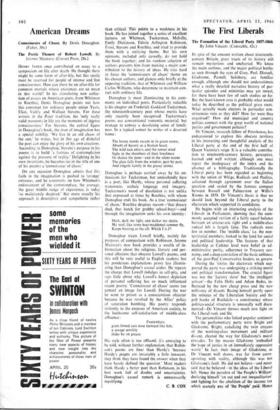The First Liberals
The Formation of the Liberal Party 1857-1868. By John Vincent. (Constable, 42s.) IN spite of the amount written about ,nineteenth- century Britain, great tracts of its history still remain mysterious and uncharted. We know the main outlines, and the major political battles as seen through the eyes of Grey, Peel, Disraeli, Gladstone, Parnell, Salisbury, are familiar enough, although one should not underestimate what a really detailed narrative history of par- ticular episodes and ministries may yet reveal, for there have been few of such studies so far. But the least-known area is probably what would today be described as the political grass roots. What actually made electors in particular con- stituencies vote as they did? How far were they organised? How did municipal and country politics connect with the great world of national parties and government policies?
Dr Vincent, research fellow of Peterhouse, has endeavoured to explore this obscure territory in his interesting and thoughtful analysis of the Liberal party at the end of the first half of Queen Victoria's reign. It is a valuable contribu- tion to nineteenth-century history, perceptive, learned and well written; although one must regret the inadequacy of the index and the absence of a bibliography. Traditionally the Liberal party has been regarded as beginning with the union of Whigs, Radicals and Peelites, achieved through agreement over the Italian question and sealed by the famous compact between Russell and Palmerston at Willis's Rooms in 1859. Dr Vincent's thesis is that we should look beyond the Liberal party to the -electorate which supported its candidates.
He begins with an interesting analysis of the Liberals in Parliament, showing that the com- monly accepted version of a fairly equal balance between an aristocratic right and a middle-class radical left is largely false. The radicals were few in number. The 'middle class,' i.e. the non- territorial members, looked to the land for social and political leadership. The • features of that leadership at Cabinet level were belief in ad- ministrative purity, adherence to TreasurY eco- nomy, and a deep conviction of the basic unfitness of the post-Peel Conservative leaders to govern.
During the 'sixties the electorate which sup- ported the party was undergoing a striking moral and political transformation. The crucial figure was not the 'factory slave' but 'the intelligent artisan'—the Felix Holts and Adam Bedes, in- fluenced by the new cheap press and the new militancy of dissent. Basing himself partly upon the minutes of the Liberation Society and the poll books of Rochdale—a constituency whose politico-social structure is unusually well docu- mented—Dr Vincent throws much new light on the Liberal rank and file.
The personalities who linked popular sentiment with the parliamentary party were Bright and Gladstone. Bright, canalising the twin streams of the working-class movement and militant dissent, cleared the way for Gladstone's moral crusades. To the masses Gladstone 'embodied the hope of justice in an immediately oppressive world.' In fact, their image of Gladstone, as Dr Vincent well shows, was far from corre- sponding with reality, although this was not Gladstone's fault. He did not believe—and never said that he believed—in the ideas of the Liberal left. Hence the paradox of 'the People's William' declaring himself 'an out and out inequalitarian and fighting for the abolition of the income tax which scarcely any of 'the People' paid. Hence too, perhaps, the ultimate failure of the Liberal party; though to pursue that theme would take us far beyond the period covered by Dr Vincent. ROBERT BLAKE































 Previous page
Previous page